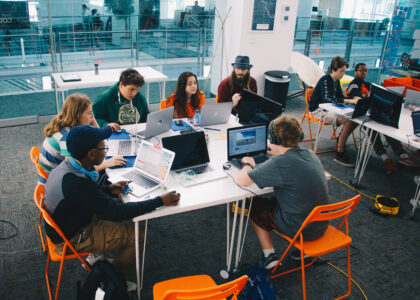Coding. When most visualize a coder, it’s typically the image of a beanie-wearing hipster sitting in a dark room hacking into a secured network. The movies may fantasize it, but coding is an extremely important skill for our ever-growing digital world.
The concept of coding isn’t a new one. The skill – part art and part science – has become a crucial part of American’s everyday lives in recent years, and only continues to intensify. Head to any grocery store and behind-the-scenes, coding is running the checkout. Every website, every app, every digital service and device requires code to properly function. And with the surge in our digital world, the call for “coders” is ever-increasing.
“Many people aren’t aware of the digital divide that exists in some of our communities. Just because kids are involved in social media, people assume all kids are by default technologically advanced and have access to such tools,” said Recreation Director, Jonathan Jones. “Our desire is to be proactive and intentional in our programming efforts to equip kids with the skills that are becoming so much more important for success now.” 
So how do we bridge the gap?
Enter: South Bend Code School.
With $10,000 worth of grants from United Way of Saint Joseph County and AT&T, Code School teamed up with the City of South Bend to create a free after-school coding program for youth within two community centers: Charles Black Center and Martin Luther King, Jr. Center. Both will be hosting their after-school students who are interested in coding for 2 months, spanning October and November. Code School will be facilitating staff and laptops, along with a fun and open learning environment.
“We’re working to bridge the gap, breaking down the stereotypes that come with coding,” said Alex Sejdinaj, South Bend Code School CoFounder. “Many people think of Bill Gates or Mark Zuckerburg, but many can’t relate to those people. It’s more about asking ‘how do I fit in?’ so we have instructors that make it as approachable as possible.”
It’s not expected that kids will walk away with a passion for coding. The learning process has been known to spark interest in other creative fields including architecture and graphic design. As they spend more time thinking creatively, students are likely to think of the endless possibilities for a career path.
“We ask them what their interests are and pair them with a coding program so they can walk away with a portfolio of coding,” Sejdinaj said. “We make sure it’s accessible any time, so we work with free software that can be used anywhere, like the library.”
Connecting underserved areas to digital services is a continuous initiative within the centers. Both have received computer room upgrades through a resource called “Click”, a new program between the St. Joseph County Library, City of South Bend, and MetroNet.
It’s not just about computers, coding or technology. Giving our youth opportunities to see potential for their future is what programs like these are all about.
“One of the greatest benefits we can give to our community is access…things that can be a bit tougher for residents to attain,” Jones said. “With these resources in place, we are thrilled for the opportunity to be able to provide such programming like what will take place thanks to Code School in our neighborhood communities.”
